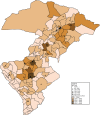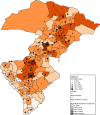Covering the Last Kilometer: Using GIS to Scale-Up Voluntary Medical Male Circumcision Services in Iringa and Njombe Regions, Tanzania
- PMID: 26374807
- PMCID: PMC4570020
- DOI: 10.9745/GHSP-D-15-00151
Covering the Last Kilometer: Using GIS to Scale-Up Voluntary Medical Male Circumcision Services in Iringa and Njombe Regions, Tanzania
Abstract
Background: Based on the established protective effect of voluntary medical male circumcision (VMMC) in reducing female-to-male HIV transmission, Tanzania's Ministry of Health and Social Welfare (MOHSW) embarked on the scale-up of VMMC services in 2009. The Maternal and Child Health Integrated Project (MCHIP) supported the MOHSW to roll out VMMC services in Iringa and Njombe, 2 regions of Tanzania with among the highest HIV and lowest circumcision prevalence. With ambitious targets of reaching 264,990 males aged 10-34 years with VMMC in 5 years, efficient and innovative program approaches were necessary.
Program description: Outreach campaigns, in which mobile teams set up temporary services in facilities or non-facility settings, are used to reach lesser-served areas with VMMC. In 2012, MCHIP began using geographic information systems (GIS) to strategically plan the location of outreach campaigns. MCHIP gathered geocoded data on variables such as roads, road conditions, catchment population, staffing, and infrastructure for every health facility in Iringa and Njombe. These data were uploaded to a central database and overlaid with various demographic and service delivery data in order to identify the VMMC needs of the 2 regions.
Findings: MCHIP used the interactive digital maps as decision-making tools to extend mobile VMMC outreach to "the last kilometer." As of September 2014, the MOHSW with MCHIP support provided VMMC to 267,917 men, 259,144 of whom were men were aged 10-34 years, an achievement of 98% of the target of eligible males in Iringa and Njombe. The project reached substantially more men through rural dispensaries and non-health care facilities each successive year after GIS was introduced in 2012, jumping from 48% of VMMCs performed in rural areas in fiscal year 2011 to 88% in fiscal year 2012 and to 93% by the end of the project in 2014.
Conclusion: GIS was an effective tool for making strategic decisions about where to prioritize VMMC service delivery, particularly for mobile and outreach services. Donors may want to consider funding mapping initiatives that support numerous interventions across implementing partners to spread initial start-up costs.
© Mahler et al.
Figures








References
-
- Njeuhmeli E, Forsythe S, Reed J, Opuni M, Bollinger L, Heard N, et al. Voluntary medical male circumcision: modeling the impact and cost of expanding male circumcision for HIV prevention in eastern and southern Africa. PLoS Med. 2011;8(11):e1001132. 10.1371/journal.pmed.1001132. - DOI - PMC - PubMed
-
- Tanzania Commission for AIDS (TACAIDS); Zanzibar AIDS Commission (ZAC); National Bureau of Statistics (NBS); Office of the Chief Government Statistician (OCGS); Macro International Inc Tanzania HIV/AIDS and malaria indicator survey 2007-08. Dar Es Salaam, (Tanzania): TACAIDS, ZAC, NBS, OCGS, and Macro International; 2008. Available from: http://dhsprogram.com/pubs/pdf/ais6/ais6_05_14_09.pdf
Publication types
MeSH terms
Grants and funding
LinkOut - more resources
Full Text Sources
Medical
Research Materials
